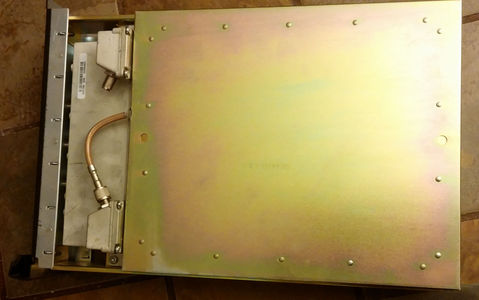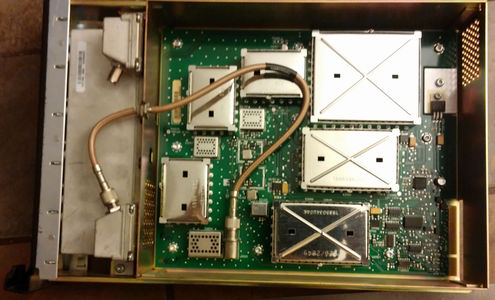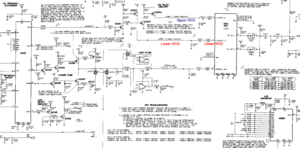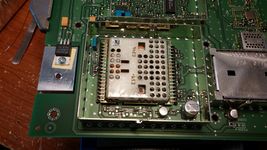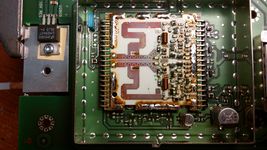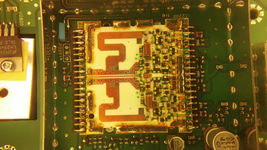Difference between revisions of "UHF Receiver"
| Line 436: | Line 436: | ||
== R3 to R2 == | == R3 to R2 == | ||
| − | + | This works in theory, VCO modification was different. Not as wide a tuning range, but appears to work. | |
| − | |||
== R4 to R2 == | == R4 to R2 == | ||
Revision as of 19:14, 4 May 2024
This page covers the Range 1 to Range 4 receivers. The Range 0 is a newer (and easier to modify) design.
Contents
Basics
The basic receiver is pictured below. Note the UHF R1-R4 receivers have a preselector that's flush with the front panel and only 3 adjustment. This is a dead give away that you have a UHF R1-R4 from the front. Unfortunately there is not an easy way to identify it further than by part number.
The receiver is a high side injection with the 1st Lo operating +73.35 MHz higher than the receiver frequency.
The SCM knows what type of module is inserted by reading voltage divider resistors on the u2600 A/D Converter. Some of these are on ports used for other things, Change Frequency and Lock and then A8 input is used for ID. Note the resistors have the same labels on the UHF boards but on other bands the same parts have different labels. The R2606 and R2607 form a voltage divider feeding the A8 input with the computed voltage in volts.
| Range | R2449 Chg Freq | R2450 Lock | SPACE | R2606 | R2607 | A8 Volts |
|---|---|---|---|---|---|---|
| UHF R0 | 0 | 3300 | 5600 | 3300 | 1.9 | |
| UHF R1 | 0 | 0 | 1200 | 1200 | 2.5 | |
| UHF R2 | 0 | 3300 | 1200 | 1200 | 2.5 | |
| UHF R3 | 3300 | 0 | 1200 | 1200 | 2.5 | |
| UHF R4 | 3300 | 3300 | 1200 | 1200 | 2.5 | |
| VHF | R2413 | R2415 | R2812 | R2814 | ||
| VHF R1 | 0 | 0 | 2700 | 1200 | 1.5 | |
| VHF R2 | 0 | 3300 | 2700 | 1200 | 1.5 | |
| 800/900 | R2422 | R2414 | R2816 | R2815 | ||
| 900 | 0 | 0 | 1200 | 4700 | 4.0 | |
| 800 | 0 | 0 | 1200 | 2700 | 3.5 |
The service manual excerpt is in PDF and below.
UHF Receiver Models TRE6281-TRE6282-TRE6283-TRE6284 Service Manual Excerpt
In PNG format.
Note on the schematic the VCO high and Low are reversed. This seems to be a recurring theme in the Quantar manuals.
As the VCO runs at 73.35 MHz higher than the intended receive frequency the VCO will expect to lock over the following ranges. The ideal spot for the VCO to operate is between 2.5 and 7.5 Volts highlighted in pink below.
| Range | Lower VCO | Upper VCO | ||||||||
|---|---|---|---|---|---|---|---|---|---|---|
| Volts | 0.8 | 2.5 | 5.0 | 7.5 | 9.2 | 0.8 | 2.5 | 5.0 | 7.5 | 9.2 |
| UHF R1 | 462 | 467 | 479 | 491 | 499 | 478 | 491 | 499 | 506 | 514 |
| UHF R2 | 498 | 511 | 519 | 527 | 536 | 514 | 527 | 535 | 543 | 552 |
| UHF R3 | 528 | 543 | 549 | 555 | 564 | 541 | 555 | 561 | 567 | 575 |
| UHF R4 | 553 | 567 | 574 | 580 | 589 | 568 | 580 | 587 | 593 | 601 |
The VCO is much like the VCO in the exciter, a sealed unit with no further diagram available from the factory.
Conversions
Converting the boards
This is changing, I have a better way, old method.
R1 to R2
This is the conversion we're focused on as there are tons of 403-433 MHz (US Federal) Range 1 units on the market for cheap.
In general you should have the following to work on this:
- Soldering iron with fine tip (Metcal suggested)
- Hot air station
- Under board heater
- Small tools/tweezers
- Flux, and other small parts for rework
- Quantar backplane extender cables (PCI extender cables cut down to fit)
Almost needed, you really should have it, but can do without:
- Voltmeter
- Service monitor/SINAD meter
- RJ-9 speaker to SINAD meter input cable.
Nice to have:
- Bench DVM
- Bench PSU
- Spectrum Analyzer and probes
Parts needed
You will need the following parts for this. Note the capacitors are critical and must be a high Q cap. Cheaper caps have been used and shown a 3-5 dB decrease in SINAD performance that was almost impossible to find and fix. Don't cheap out.
| Value | Tolerence | Part(s) | Digikey partnumber | Size |
|---|---|---|---|---|
| 3.3 | +-0.1pf 50v | C2070 | 600F3R3BT250XT | 0805 |
| 5.6 | +-0.25pf 50v | C2076, C2079 | 600F5R6CT250T | 0805 |
| 6.8 | +-0.1pf 50v | C2054 | 600F6R8BT250XT | 0805 |
| 8.2 | +-0.1pf 50v | C2050 | 600F8R2BT250XT | 0805 |
| 13 | +-2pf 50v | C2051, C2059 | QSCT251Q130G1GV001E | 0805 |
| 16 | +-2pf 50v | C2053, C2057 | QSCT251Q160G1GV001E | 0805 |
| 22 | 5% 50v | C2083 | 600F220JT250XT | 0805 |
| 3300 | 5% 1/8 watt | R2450 | RMCF0805JT3K30 | 0805 |
Procedure Overview
In general the VCO (both) need to be moved up in frequency and the image filters from the mixer need to be moved up by changing some chip caps. The ID resistors of the board must be changed to identify the receiver as Range 2 as well. Prior procedures required a bunch of manual power supplies, sweeping the circuit, and monitoring with a spectrum analyzer. This procedure uses the Quantar to control the receiver as it's being worked on using an extender cable.
The VCO must be modified so that it's able to lock from 2.5 to 7.5v. The steering voltage actually is usable from .95 to 8.95v, but tempeture will affect the resonance of the VCO, and so you want to have the high and low frequency to be at 2.5 - 7.5 volts giving enough room on each side for environmental variations.
Preparation
First lets prep the setup and get some notes on the receiver before we move it.
Setup the Quantar and install the extender cables.
Remove the receiver from it's housing.
Install the board in the holder.
Hook it up to the backplane and program in the Range 1 test codeplug.
Sweep and record the VCO steering voltage on each channel where it locks. If not using a voltmeter, you can use the measurement screen in RSS to see the steering level. This is very important as it gives a base line of performance on the receiver before modification.
Note that if you're using a volt meter on the VCO steering line, it will not receive properly. Ensure you do that separate from the SINAD testing.
| Lower VCO | Upper VCO | |||||||||||||||
|---|---|---|---|---|---|---|---|---|---|---|---|---|---|---|---|---|
| Channel | 1 | 2 | 3 | 4 | 5 | 6 | 7 | 8 | 9 | 10 | 11 | 12 | 13 | 14 | 15 | 16 |
| R1 | 384.5250 | 388.2250 | 391.9250 | 395.6250 | 399.3250 | 403.0250 | 410.5000 | 417.9750 | 418.0250 | 425.5000 | 432.9750 | 436.8000 | 440.6250 | 444.4500 | 448.2750 | 452.1000 |
| R2 | 417.9000 | 421.9250 | 425.9500 | 429.9750 | 434.0000 | 438.0250 | 446.0000 | 453.9750 | 454.0250 | 462.0000 | 469.9750 | 474.1250 | 478.2750 | 482.4250 | 486.5750 | 490.7250 |
| R1 Shield on | UNLOCK | UNLOCK | 1.813 | 2.504 | 3.248 | 4.029 | 5.678 | 7.379 | 3.843 | 5.495 | 7.204 | 8.089 | 8.982 | UNLOCK | UNLOCK | UNLOCK |
| R1 Shield Off | UNLOCK | 1.808 | 2.480 | 3.203 | 3.962 | 4.743 | 6.376 | 8.045 | 4.735 | 6.395 | 8.084 | 8.959 | UNLOCK | UNLOCK | UNLOCK | UNLOCK |
| Delta | 0.667 | 0.699 | 0.714 | 0.714 | 0.698 | 0.666 | 0.892 | 0.900 | 0.880 | 0.870 | ||||||
| R1 SINAD | -120.1 | -120.1 | -120.0 | -120.1 | -120.1 | -120.2 | -120.0 | -120.0 | -120.0 | -119.4 | 119.4 | |||||
| R2 Shield On | UNLOCK | UNLOCK | 1.328 | 2.056 | 2.876 | 3.766 | 5.680 | 7.727 | 2.319 | 4.001 | 5.890 | 6.920 | 7.968 | 9.027 | UNLOCK | UNLOCK |
| R2 SINAD | ||||||||||||||||
VCO Modification
This is very critical circuit to work on and is a sealed ceramic unit. Motorola used unique VCO's for each band range, however the Range 1 can be modified using some "stub" lines of copper foil to bring it's frequency up. This is complicated as the unit is soldered in place and has a heavy plated steel cover soldered over it.
Prepare the VCO for rework
The VCO shield must be removed, but as the entire VCO will be reflowed at the same time, it will "fall" off the headers holding it off the board. This is solved by using some 1/4 inch wide 60 mil thick silicone stock. Fold the small pieces under the VCO and compress them to provide some slight pressure between the bottom of the VCO and the top of the PCB. This works as the headers will not be reflowed and release from the PCB.
After this is done, flip the board over and unsolder the 4 posts of the shield that go to ground. I find the best way to do this is lots of flux and solder braid with a pre-heated board, but chip-quick solder will work to lower the melting point so that when the top reflows the ground will too. Either way will work.
Now flip the board back and let it pre-heat. A bit of insulation over the VCO will help for this. I set my pre-heater to 550f and let it rip for 5-10 min.
Set the hot air gun to 570F and 15 L/min of flow, slowly work the shield up in temp and test the solder melting around it. Once it's completely reflowed, lift up on the center of the shield and pull it directly up and clear of the PCB. Set it aside to cool. Careful you don't disturb any of the VCO parts, as they will most likely be reflowed. If you do, don't panic, just look at the before picture and put everything back to how it was on the VCO. It's a pretty easy circuit to figure out.
Before allowing the VCO to cool, tin the U portions of each VCO strip with solder and flux. Once this is done put the insulation over the VCO module and turn the pre-heater off, allow it to cool but not fast, as rapid changes can crack the ceramic PCB.
Modify the VCO
Power up the Quantar and the receiver. Ensure it's locked and you can read the steering voltages on the VCO. Now you need to program the Range 2 Test Codeplug into the quantar and let it reload. It should show up as receiver PLL unlocked when it boots, this is ok.
Prep two copper foil strips to 50 mil wide by .250 long. If the foil has adhesive on one side, remove it using some solvent.
Turn on the pre-heater and let it warm the VCO up, you will see the VCO voltage move as this happens.
VCO RULES
- Temp up = Volts up
- Temp down = Volts down
- Case off = Volts up
- Case on = Volts down
- Grinding the trim cap = Volts down
- Move short towards U = Volts up
- Move short away from U = Volts down
The concept is that we want the most tuning range from the VCO we can get, but that the 6-8 and 9-11 channels are all within 2.5-7.5v under normal operations once the VCO is reassembled.
First modify the lower VCO. This is best done on channel 7, as from solder hot temp to room temp, .75 to 1v higher is seen. Adding this to the +.7 to +.9v seen by removing the case, means we'll be adjusting the unit to almost 2v higher than it will be once reassembled. As we want to hit 7.5v at channel 8, we will run out of steering voltage trying it.
Set on channel 7 and solder the copper foil short over the lower VCO U bend in such a way that it shows 7.3-7.4v on the steering line. The VCO may unlock when hot, so solder it and then let it cool slightly to lock again. A small blowing on it may help. In practice it's better to have it slightly high as the stub can be ground with dimod dremmel tool to shift the voltage down after it's done. Once you have the hang of it soldering it actually not bad on the VCO.
Now to the upper VCO, and here we set to channel 9, and want 3.9-4v while hot. This may require bit more cooling to get it to lock between iterations, but it will lock easily.
Once the VCO is moded you can allow it to cool and test it more, or just reinstall the shield right now. If you allow it to cool, ensure you have the insulator on it while it cools, and record the shield off voltages before re-attaching the shield. If you do allow it to cool, use some solvent and remove all the flux from the VCO substrate, while it shouldn't affect anything, it will look better.
To reattach the shield, place the shield on the VCO and add a liberal amount of flux around it. Using the hot air gun to 570F and 15 L/min of flow reflow it and allow it to seat on the VCO. You may need to add some extra solder around the VCO shield, but typically there's more than enough to make it work. Once it's totally reflowed allow it to cool and solidify. As you need to solder the under side of the board, you can do that from the top, or flip it over and solder it.
Allow it all to cool using the insulator over the VCO again.
Test the VCO
Test the cooled VCO is locked across the channels 6-11, and note the voltage on channel 8 (Low VCO highest frequency) and channel 9 (high VCO lowest frequency), which should be 7.5 and 2.5 v respectively. If it's too high, you can grind the trimmer cap and bring it down, but within half a volt is probably OK. If you'll be operating the station at tempeture extremums its more important, or if you intend to operate it out of the 438-470 MHz band.
Modify the image filters
Image filter under shield
Image filter in mixer can
Clean board
test and verify
R3 to R2
This works in theory, VCO modification was different. Not as wide a tuning range, but appears to work.
R4 to R2
No data on this yet, may be doable VCO will be a problem.


